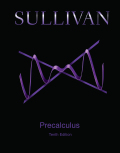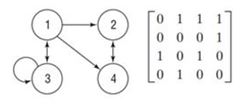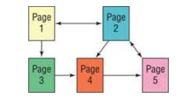
In graph theory, an adjacency matrix, A, is a way of representing which nodes (or vertices) are connected. For a simple directed graph, each entry, , is either 1 (if a direct path exists from node i to node j) or 0 (if no direct path exists from node i to node j). For example, consider the following graph and corresponding adjacency matrix.  The entry is 1 because a direct path exists from node 1 to node 4. However, the entry is 0 because no path exists from node 4 to node 1. The entry is 1 because a direct path exists from node 3 to itself. The matrix indicates the number of ways to get from node i to node j within k moves (steps).
The entry is 1 because a direct path exists from node 1 to node 4. However, the entry is 0 because no path exists from node 4 to node 1. The entry is 1 because a direct path exists from node 3 to itself. The matrix indicates the number of ways to get from node i to node j within k moves (steps).
Website Map A content map can be used to show how different pages on a website are connected. For example, the following content map shows the relationship among the five pages of a certain website with links between pages represented by arrows.  The content map can be represented by a 5 by 5 adjacency matrix where each entry,
, is either 1 (if a link exists from page i to page j) or 0 (if no link exists from page i to page j).
The content map can be represented by a 5 by 5 adjacency matrix where each entry,
, is either 1 (if a link exists from page i to page j) or 0 (if no link exists from page i to page j).
(a) Write the 5 by 5 adjacency matrix that represents the given content map.
(b) Explain the significance of the entries on the main diagonal in your result from part (a).
(c) Find and interpret .
Want to see the full answer?
Check out a sample textbook solution
Chapter 11 Solutions
EBK PRECALCULUS
- Determine whether the lines L₁ : F(t) = (−2, 3, −1)t + (0,2,-3) and L2 : ƒ(s) = (2, −3, 1)s + (−10, 17, -8) intersect. If they do, find the point of intersection. ● They intersect at the point They are skew lines They are parallel or equalarrow_forwardAnswer questions 2arrow_forwardHow does a fourier transform works?arrow_forward
- Determine the radius of convergence of a power series:12.6.5, 12.6.6, 12.6.7, 12.6.8Hint: Use Theorem12.5.1 and root test, ratio test, integral testarrow_forwardCan you answer this question and give step by step and why and how to get it. Can you write it (numerical method)arrow_forwardCan you answer this question and give step by step and why and how to get it. Can you write it (numerical method)arrow_forward
- There are three options for investing $1150. The first earns 10% compounded annually, the second earns 10% compounded quarterly, and the third earns 10% compounded continuously. Find equations that model each investment growth and use a graphing utility to graph each model in the same viewing window over a 20-year period. Use the graph to determine which investment yields the highest return after 20 years. What are the differences in earnings among the three investment? STEP 1: The formula for compound interest is A = nt = P(1 + − − ) n², where n is the number of compoundings per year, t is the number of years, r is the interest rate, P is the principal, and A is the amount (balance) after t years. For continuous compounding, the formula reduces to A = Pert Find r and n for each model, and use these values to write A in terms of t for each case. Annual Model r=0.10 A = Y(t) = 1150 (1.10)* n = 1 Quarterly Model r = 0.10 n = 4 A = Q(t) = 1150(1.025) 4t Continuous Model r=0.10 A = C(t) =…arrow_forwardUse a graphing utility to find the point of intersection, if any, of the graphs of the functions. Round your result to three decimal places. (Enter NONE in any unused answer blanks.) y = 100e0.01x (x, y) = y = 11,250 ×arrow_forward5. For the function y-x³-3x²-1, use derivatives to: (a) determine the intervals of increase and decrease. (b) determine the local (relative) maxima and minima. (e) determine the intervals of concavity. (d) determine the points of inflection. (e) sketch the graph with the above information indicated on the graph.arrow_forward
- Can you solve this 2 question numerical methodarrow_forward1. Estimate the area under the graph of f(x)-25-x from x=0 to x=5 using 5 approximating rectangles Using: (A) right endpoints. (B) left endpoints.arrow_forward9. Use fundamental theorem of calculus to find the derivative d a) *dt sin(x) b)(x)√1-2 dtarrow_forward
 Linear Algebra: A Modern IntroductionAlgebraISBN:9781285463247Author:David PoolePublisher:Cengage Learning
Linear Algebra: A Modern IntroductionAlgebraISBN:9781285463247Author:David PoolePublisher:Cengage Learning
